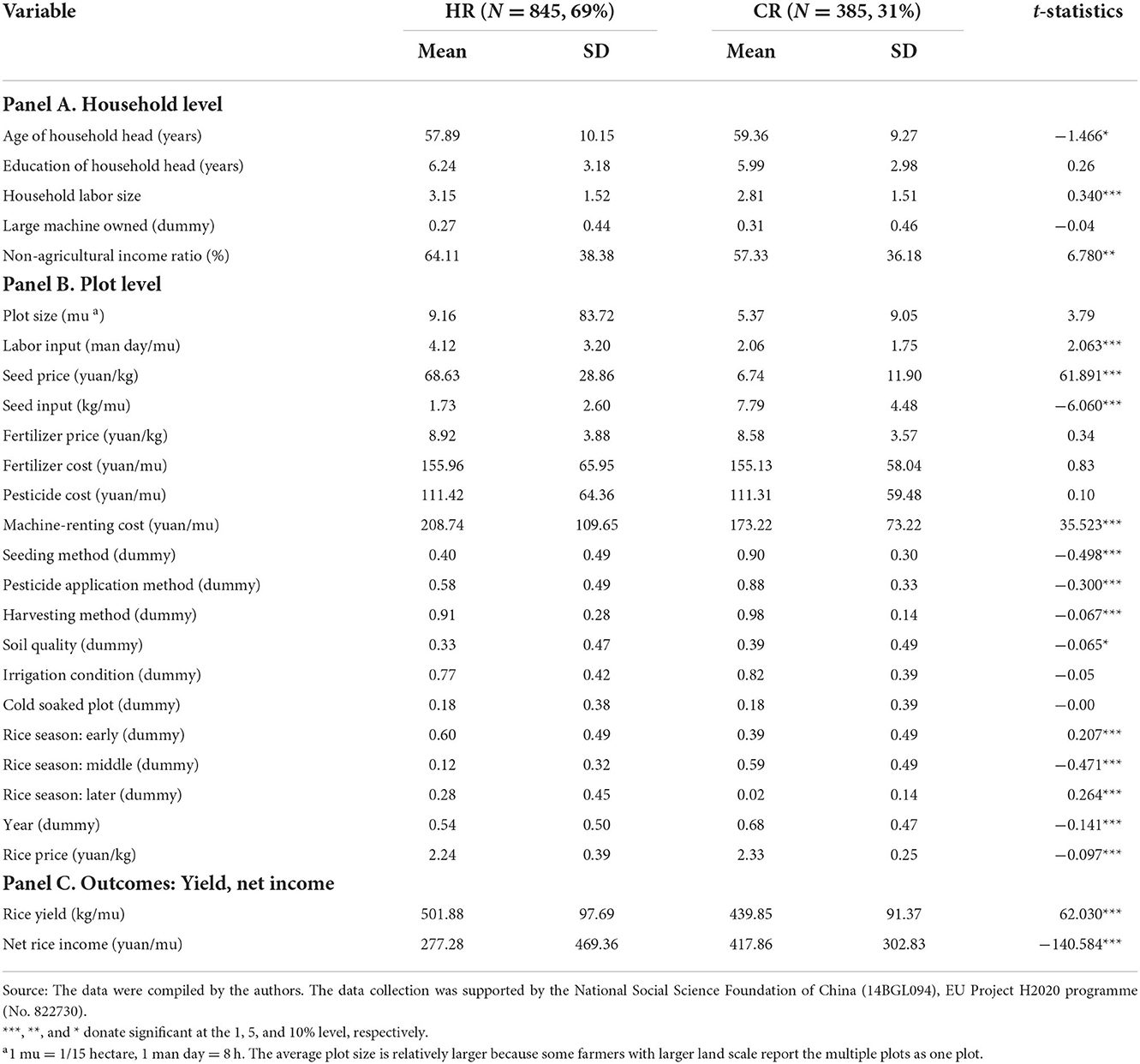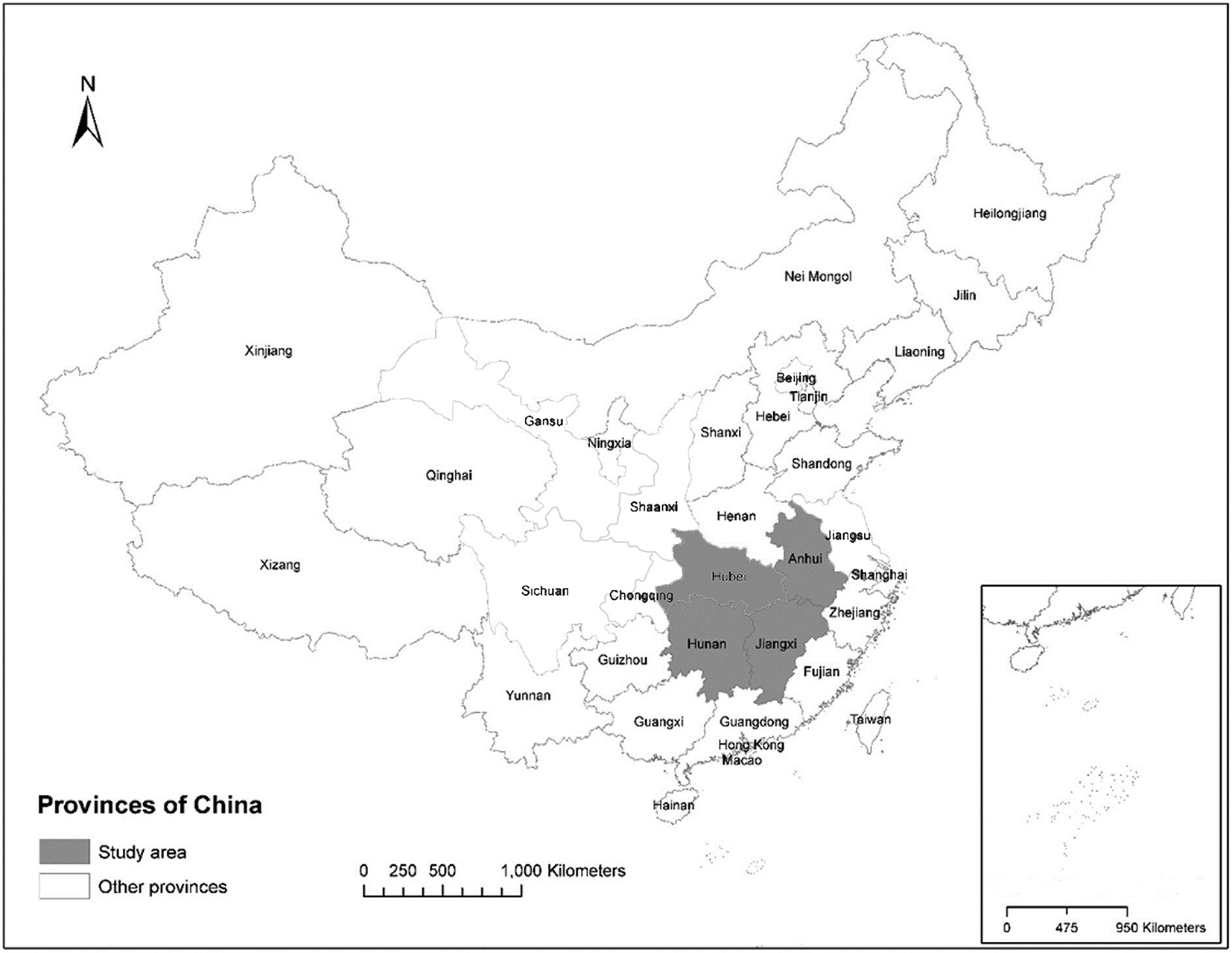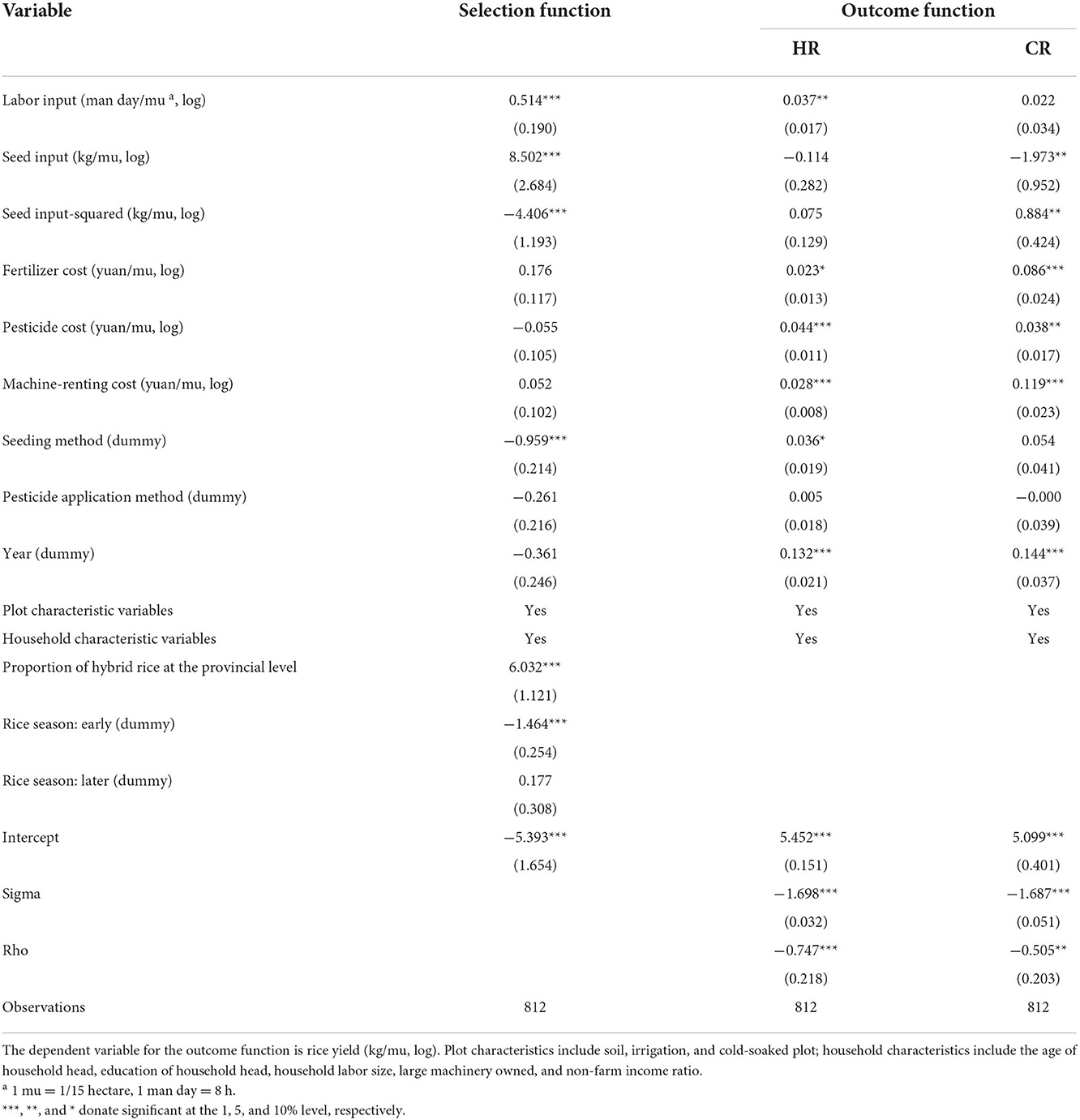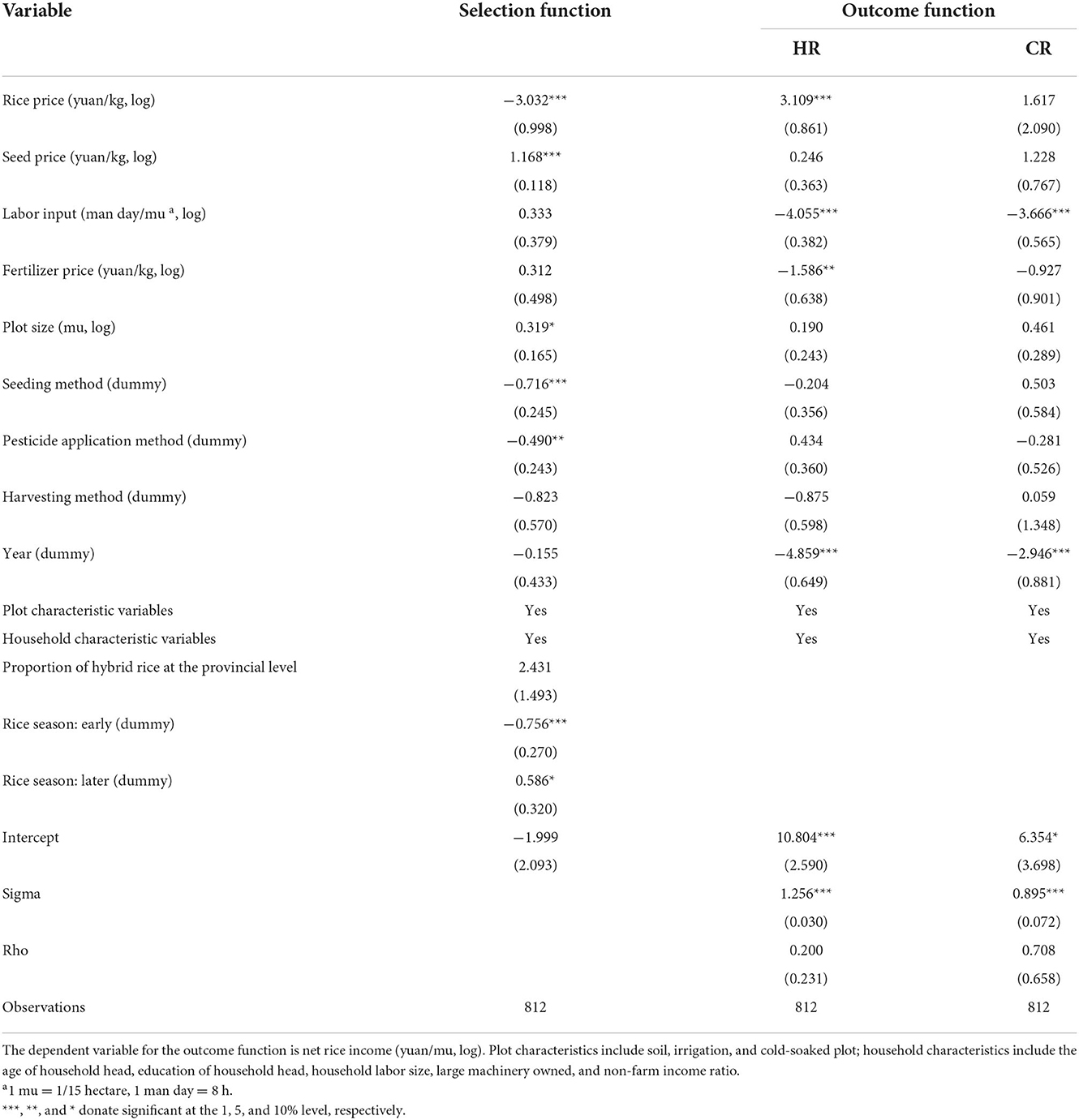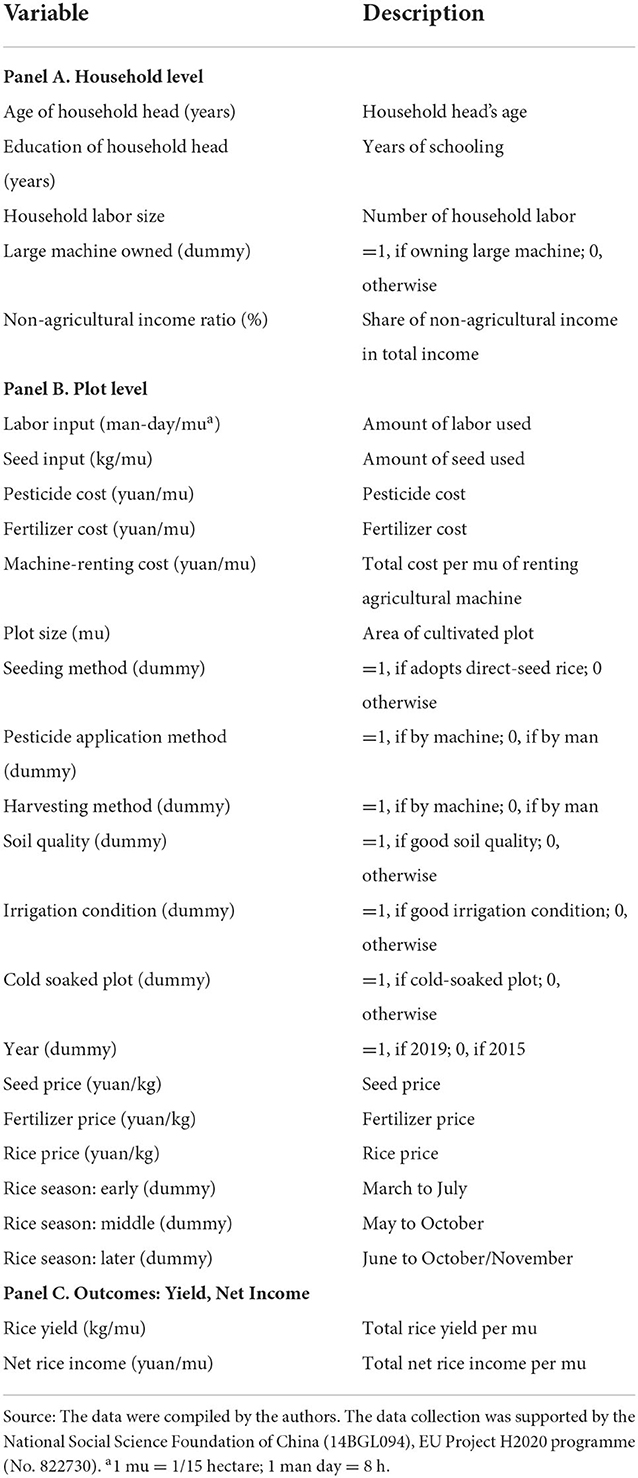- 1College of Economics and Management, South China Agricultural University, Guangzhou, China
- 2Department of Marketing, School of Business Administration, Guangzhou Institute of Science and Technology, Guangzhou, China
- 3Kemper and Ethel Marley Foundation Chair, Morrison School of Agribusiness, W. P. Carey School of Business, Arizona State University, Mesa, AZ, United States
- 4Department of Economics, Lingnan College, Sun Yat-sen University, Guangzhou, China
The hybrid rice technology could be considered a boon for food security for many in South and Southeast Asia to increase rice productivity. In China, the birthplace of hybrid rice (HR), the diffusion of hybrid rice started in 1976. About 28% rice-growing area in China is planted with hybrid rice. However, the proportion of HR area in China has been declining in recent years, and farmers in surrounding countries are reluctant to adopt it because of high seed costs, farm management practices, and quality issues. Most previous research on the evaluation of hybrid rice variety on yield does not control input level. This study uses the endogenous switching regression method to analyze the impacts of HR adoption on rice yield and net rice income. The study uses plot- and household-level data from four southern provinces of China. Findings show a significant effect of HR adoption on rice yields. On the same HR plots, compared to CR adopters, rice yield increases by 4.86% for HR adopters. Rice yield would increase by 4.72% if the HR variety was adopted on the same conventional rice (CR) plots. Additionally, findings show a significant effect of HR adoption on net rice incomes. On the same HR plots, compared to CR adopters, net rice income decreases by 43.61% for HR adopters. Similarly, net rice income would reduce by 10.95% if the HR variety was adopted on the same CR plots. Thus, adopting HR increases rice productivity, but Chinese farming households that adopted CR would not benefit from adopting HR. Policymakers can formulate a systematic and comprehensive rice breeding plan to guide the simultaneous development of rice variety yield and quality improvement. Additionally, policymakers, in conjunction with private companies, could enact policies to reduce the cost of hybrid rice seed or improve the production efficiency of HR. For example, they could incentivize the development of HR varieties suitable for direct seeding and seed-saving sowing methods (rice trans-planter).
Introduction
The Green Revolution that began in the 1960s solved a widening Asian food crisis in the 1960s and lifted tons of people out of poverty (Evenson and Gollin, 2003; Hazell, 2009).1 China is the largest rice-producing and rice-consuming country in the world. Indeed, rice accounts for 30 percent of the total grain acreage in China and 34% of grain output in 2019. China's rice crop supplies 28% of the global rice supply (FAOSTAT, 2015). Li et al. (2009) argue that the Chinese rice sector still faces surpluses or deficits in rice production. As a result, Chinese consumers are directly affected by increased variability in rice prices. China still faces population pressures and a land-population crisis. China wants to increase agricultural output for food security and the livelihood of millions of Chinese. To this end, China has used hybrid rice technology to increase rice yield per unit. Li et al. (2009) note that rice yields increased by 44% due to hybrid rice varieties, and rice acreage decreased by 14% between 1978 and 2008. Indeed, increased rice output has helped feed 60 million more Chinese annually.
Figure 1 shows the total rice-growing area planted with hybrid rice (solid line) and conventional rice (dash line) from 1983 to 2019. On the one hand, the figure reveals that the area planted with hybrid rice grew rapidly until the early 1990s. Since then hybrid rice area appears to flatten out with fluctuations until 2008. Strikingly, after 2008 the area under hybrid rice has been steadily declining. On the other hand, Figure 1 shows that area planted with conventional rice (CR) first decreased and then rebounded steadily since 2003. One can also observe that the planting gap between HR and CR was minimal in 2019. Not surprisingly, the above national pattern holds for the four provinces from which we collected our data (see Figure 2). Indeed, Table 1 shows that the yield from the hybrid rice variety is higher than the average yield of conventional rice of the four provinces in our study.
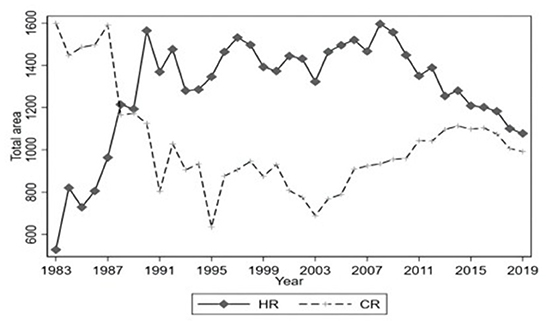
Figure 1. Cultivation Area of HR and CR in China from 1983 to 2019 (unit: 10,000 ha). Source: Statistical Table of the Popularization of Main Crop Varieties in China, obtained from the China Agricultural Technology Extension Service Center. Notes: The data only includes rice varieties with a cultivation area larger than 100,000 mu (15 mu = 1 ha).
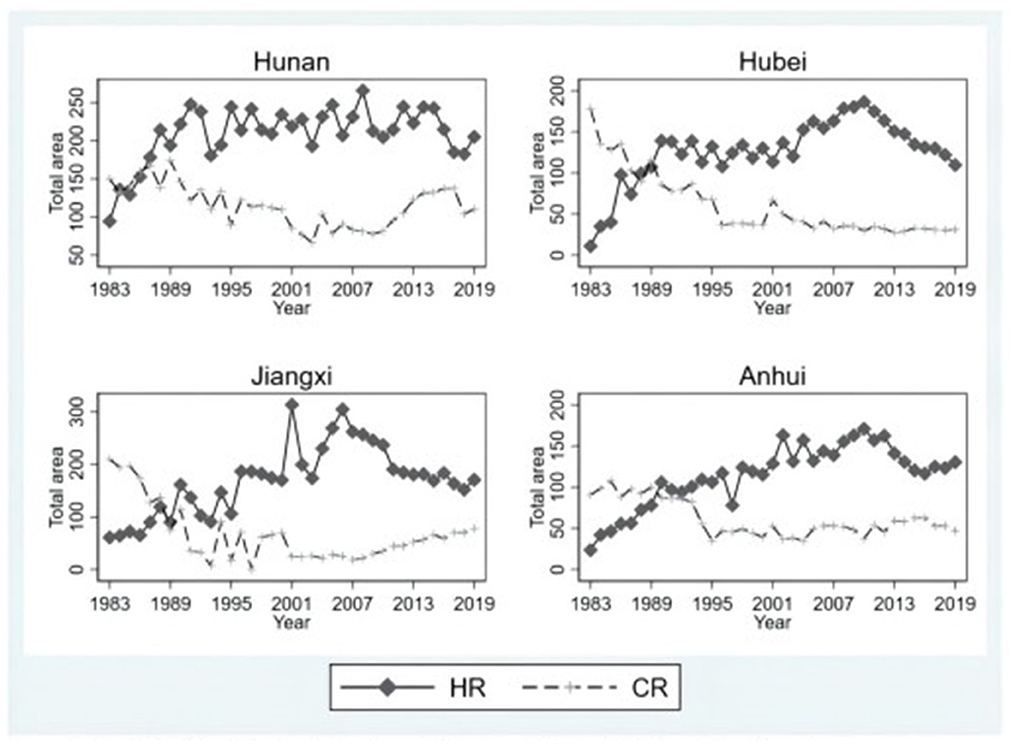
Figure 2. Cultivation Area of HR and CR from 1983 to 2019 by Surveyed Provinces (unit: 10,000 ha). Source: Statistical Table of the Popularization of Main Crop Varieties in China, obtained from the China Agricultural Technology Extension Service Center. Notes: The data only includes rice varieties with a cultivation area larger than 100,000 mu (15 mu = 1 ha).
Despite their contributions over time and space, some studies show that the hybrid rice varieties are not attractive to farmers in several Asian countries (Janaiah et al., 2002; Spielman et al., 2017; Digal and Placencia, 2020). In addition, recent years have witnessed a decrease in the adoption of hybrid rice varieties in China (see Figures 1, 2). Although hybrid rice has a yield advantage, it also has higher input costs and lower market prices. In addition, with an improved breeding method, conventional rice can achieve high yields today. As a result, hybrid rice may not outperform conventional rice from the perspective of economic performance. Thus, rice farmers prefer conventional rice varieties when considering the difference in price, yields, and inputs.
Therefore, the objective of this study is to provide an economic assessment of hybrid rice vs. conventional rice using plot-level repeated cross-sectional data collected from four major rice-growing provinces in southern China. Specifically, the study examines the impact of HR and CR on rice yields and net income earned from rice cultivation. We confirm hybrid rice has higher yields and input costs than conventional rice. We do not find strong evidence that hybrid rice would generate a higher net income for rice farmers in China. Our results have implications regarding the future direction of seed breeding. Policymakers should invest in breeding hybrid rice varieties to produce better grain quality at a lower cost. In addition, breeding methods of conventional modern rice varieties should also be encouraged.
Background and literature review
Using a three-line system, Chinese rice breeders started the hybrid rice program in 1964. In 1975 the hybrid rice (HR) technology became commercialized, and large-scale production of HR began in China. HR technology started to diffuse in China in 1976.2 About 28% of China's rice-growing area was planted with hybrid rice by 1986 (Lin, 1991). The main advantage of hybrid rice is its high yield. In 1981, researchers in China bred a hybrid rice seed variety that yielded more than 500 kg/mu3 (Xie et al., 1987; Ren et al., 2016; Wu et al., 2018). For example, Lin (1994) found that the yield advantage of hybrid rice over conventional rice is about 19% in China. Interestingly, more than a decade later, Zhao (2008) found that the yield advantage of hybrid rice over conventional rice was reduced to 12%. In other large rice-consuming Asian countries, the yield advantage of hybrid rice gain is about 15–20% higher than the high-yielding modern varieties (Janaiah et al., 2002; Mottaleb et al., 2015). In contrast, a recent study by Chau and Scrimgeour (2022) of Vietnamese rice farmers found that hybrid rice provided no yield superiority over high-yielding inbred rice. The authors tend to corroborate Lu et al.'s (2020) findings that inbred lines have higher yields than hybrid rice under higher planting density and reduced nitrogen application rate.
In terms of input demand, however, it is not clear that hybrid rice is less costly, and the findings in the literature seem mixed. Although hybrid rice uses less labor input and draft animal services, it demands more chemical fertilizer (Lin, 1994). Other studies show that hybrid rice uses less fertilizer (Li et al., 2014; Jammalamadaka and Deka, 2020). Finally, in recent research using experimental plot-level data, Lu et al. (2020) found that increasing planting density can reduce nitrogen application in rice production using inbred rice varieties. To that end, increasing planting density required a higher seeding rate in rice production. In other words, rice farmers have to use more seeds. Commercial companies in China produce hybrid rice seeds. Indeed, private companies are engaged in rice seed production across many countries in Asia, including India, Nepal, and Indonesia (Mishra et al., 2016). However, the price of hybrid rice seed is much higher than that of conventional rice seed (about ten times higher in our sample, see Table 1). Chau and Scrimgeour (2022) report that hybrid rice seeds cost twice as much as inbred seed varieties. Finally, labor and land preparation costs are two major rice production costs affecting rice farmers' bottom line. In recent years, Chinese rice farmers have adopted the direct-seeded rice (DSR) establishment method that uses less labor and reduces land preparation costs. However, Mishra et al. (2017) and Sha et al. (2019) noted that the DSR establishment method requires more seed quantity. Given the higher hybrid seed prices and the DSR method requiring more seed quantity, it is optimal for farm households to switch to conventional rice with lower seed costs. Most previous studies on the impact of hybrid variety on rice yields did not control for the input differences, which may exaggerate the effects of varietal differences.
The rice breeding method of conventional rice has undergone significant changes in recent years. As a result, the yield potential of conventional rice has increased significantly. Studies by Yang et al. (2004) and Zhang et al. (2015) argue that some conventional rice seed varieties can reach a similar or even higher yield level as hybrid rice seed varieties. In contrast, the yield potential of hybrid rice has not improved compared to what it was two decades ago. Thus, the yield advantage of hybrid rice is not very appealing today. In addition, conventional rice has better quality and taste for human consumption (Yang et al., 2004; Fu et al., 2014), partially putting downward pressure on the market price of hybrid rice (Janaiah et al., 2002; Digal and Placencia, 2020). Specifically, we argue that small farmers who plant rice for home consumption pursue rice cultivation for quality and taste. Thus, they are more likely to plant or buy conventional rice. In the case of commercial or semi-commercial farms, farmers are more likely to consider income and production costs that are partly derived from the market price of rice and prevailing input prices. Furthermore, according to our survey data, we found that the market price of conventional rice is indeed higher than that of hybrid rice. The choice of conventional rice versus hybrid rice based on rice quality remains a question beyond this paper's scope.
The large-scale production and promotion of hybrid rice varieties, known as the Green Revolution, a breakthrough in crop science and technology in the 1960s, was a boon to the world for global food security (He et al., 2020; Mishra et al., 2022). However, the impact of the adoption of hybrid rice technology on the natural ecological environment cannot be ignored. We know that excessive use of fertilizers and pesticides that go along with hybrid rice negatively impacts the natural environment. Lin (1994) found that compared with conventional rice, the use of chemical fertilizer in hybrid rice increased by 6%. In addition, Fan (2020) believes that Green Revolution technologies, such as high-yield rice, have a negative impact on the natural ecological environment because of the use of large amounts of fertilizer and stresses on irrigation water resources, land degradation, and biodiversity damage. In a recent study, Mishra et al. (2022) concluded that new rice technologies should be developed with sustainable natural resource management, including water and land management. The authors note that sustainable production methods such as DSR can increase production even as land availability decreases and the frequency of water shortages increases.
Recently, some scholars argued that the economic advantage of hybrid rice has been disappearing in China (Fu et al., 2014; Liu et al., 2014). Combined with the above argument, it is unclear if hybrid rice would consistently outperform conventional rice economically. Scholars have documented that hybrid rice would be more profitable in China (Chen and Ma, 1984; Tao, 1987), the Philippines (Casiwan and Morooka, 2007) and India (Gogoi et al., 2020). We add to this literature by providing a quantitative assessment of the economic performance of hybrid rice versus conventional rice with micro-level data recently collected from four provinces in southern China. Our results shed light on the future directions of rice breeding programs, focusing on food policies for Asian countries, especially those with a large populations in China and India.
Data and descriptive analysis
In this section, we introduce our data and present descriptive statistics. We use 2-year repeated cross-sectional data containing detailed information on rice farmers in a major rice-growing area in Southern China. Since the middle and lower areas of the Yangtze River in China are the major rice-growing areas, we selected four provinces (Hunan, Hubei, Jiangxi and Anhui, see Figure 3). We selected Liling City and Nanxian in Hunan Province, Gong'an County, and Jianli County in Hubei Province; Xinjian County in Jiangxi Province; Tongcheng City in Anhui Province. Furthermore, we selected two villages in one town in each city (county) selected above. Finally, we randomly selected about 35 rice farmers from each village according to the name list of rice farmers supplied by the village committee. We collected detailed information on household characteristics for each household, including the age and education of the household head, family labor size, off-farm employment experience, and large agricultural machinery owned by the household. More importantly, we collected detailed plot-level data on rice seed variety adopted (HR vs. CR), farming patterns and system (e.g., seeding method, pesticide application method, harvesting method, irrigation method, and rice seasons), cost of rice production (e.g., seed price and input, hired labor, and pesticide and fertilizer costs), rice yield, prices, income from rice farming, and land characteristics (e.g., size, soil quality, and cold-soaked degree). Given that we have plot-level information, we use the plot as the unit of analysis.
Table 1 presents the summary statistics and comparison of means of variables of interest between HR and CR plots (see Table A1 in Appendix for detailed variable definitions). In our sample, the farm households adopted HR (CR) seed variety for 69% (31%) of their land plots. Panel A of Table 1 presents the mean comparisons of household characteristics. The average age of household heads adopting HR seed variety is around 58, a year younger than their counterparts. There is no significant difference in household head years of schooling between farms HR and CR seed varieties, both of which approximately completed primary-school education (about 6 years of education). The mean household labor size of the families adopting the HR seed variety is significantly larger than their counterparts, even though the magnitude of the difference is not sizeable. Farm households adopting CR seed variety tend to be more likely to own large agricultural machinery (about 31%). In contrast, 27% of farmers adopting HR seed varieties own large machinery. Farm households adopting HR seed variety tend to earn more non-agricultural wage income than their counterparts.
Panel B of Table 1 reports the results of plot-level comparisons, focusing mainly on inputs of rice production. On average, the HR plot size is larger than the CR plot size, about 3.79 mu.4 The above finding is consistent with the patterns observed in Figure 2. The seed price difference between the HR and CR plots is the most noticeable. The seed price of HR plots is about 69 yuan/kg, about ten times more than seed prices for CR plots. Although the seed input (1.7 kg/mu) is smaller for the HR plots than for the CR plots (7.8 kg/mu), the overall seed cost remains much higher than for the CR plots. For fertilizer and pesticide costs, the differences are not significant. Farm households with HR plots rent more machinery for cultivating and harvesting, indicating that farm families are less likely to own agricultural machines (see Panel A in Table 1).
The farm households use the DSR establishment method for 90% of the CR plots. However, only 40% of the HR plots use the DSR method. This is partly because the DSR establishment method requires more seed inputs (Sha et al., 2019). We do not observe a significant difference in plot quality between the HR and CR seed varieties. For instance, both plots have similar soil quality and cold-soaked levels. On average, Chinese rice farmers adopt the HR seed variety in the middle and later rice growing seasons. In contrast, Chinese farmers adopt the HR seed variety in the early and later rice-growing seasons. Lastly, we can see that the market price of CR is significantly higher than that of HR. Panel C of Table 1 compares the rice yield and income for HR and CR plots. The HR plots have higher yields, about 502 kg/mu, than the CR plots (440 kg/mu). Meanwhile, the CR plots have a higher net income from rice, about 418 yuan/mu, than the CR plots (277 yuan/mu).
Empirical framework
We use the endogenous switching regression (ESR) model to conduct our empirical analysis. We can view the farm households adopting hybrid rice (HR) seed variety and conventional rice (CR) seed variety as the treatment and control groups, respectively. Because the farm households may self-select into adopting HR seeds, the treatment (i.e., adopting HR seed variety) is endogenous, resulting in sample-selection bias (Heckman, 1979). The ESR model can account for this bias using a two-step estimation procedure. First, we model the adoption choices of farm households and estimate a selection equation. A farm household adopts HR seed variety based on the expected utility. Specifically, a Chinese rice farmer will adopt the HR seed variety if the expected utility from adopting the HR seed variety is greater than not adopting (or CR seed variety). In other words, the expected utility of adoption of HR seed variety, , is higher than the expected utility of CR seed variety, , where i denotes a plot. In the data, we can only observe whether a farm household adopts HR seed variety for a plot or not (indicated by Ui: an indicator variable) but fail to observe and . Using this framework, we estimate a probit model as follows:
where Zi is a vector of plot and household attributes, and α is a vector of parameters to be estimated. ϵi, U is the error term with a standard normal distribution.
Second, we then estimate the outcome equation based on the selection equation. We specify the following two regime equations (HR and CR plots) to explain the outcome variables:
where Yi, HR and Yi, CR are the outcomes of our interest (namely, yield and net rice income) if a farm household adopts HR and CR seed varieties for land plot i, respectively. Only one of Yi, HR and Yi, CR is observable for land plot i, so we need to construct the counterfactual outcome to estimate the treatment effects. Xi includes plot-level and household-level explanatory variables, which we allow to be overlapped with Zi, following Fuglie and Bosch (1995). βHR and βCR are vectors of parameters to be estimated. Finally, ϵi, HR and ϵi, CR are error terms, both of which are assumed to have a normal distribution. All the three error terms (ϵi, U, ϵi, HR and ϵi, CR) have the following variance-covariance structure:
where ρ′s are correlation coefficients and σ′s are standard deviations. Finally, to estimate the treatment effects of adopting the HR seed variety, we construct the counterfactual outcome for plots when farm households adopt HR seed variety and plots when farm households adopt CR seed variety (Mishra et al., 2017). In total, we have the following four cases:
where λ is the inverse Mills ratio. Based on the observed and constructed counterfactual outcomes, we now can estimate the treatment effects of adopting HR variety and not adopting HR seed variety as follows:
For each of our outcomes (yield and net rice income), we can calculate ATT and ATU, respectively.
Results and discussion
The empirical model was estimated using STATA software. The ESR models were used to evaluate the factors affecting rice yields and incomes and assess the impact of HR adoption on yields and net rice income.
Impact on rice yields
Table 2 presents the estimated impact of the adoption of HR on rice yields. In our study, we could not reject the Cobb-Douglas specification of the production function.5 Addtionally, the lower part of Table 2 reveals the coefficient of IMR was negative and statistically significant, and estimated covariance terms and statistics confirm heterogeneity, indicating that without the correction, estimates from the model would have resulted in biased estimates (downward-biased). In addition to the factors of production, we also control for variations in household attributes (education, age, experience, family size) and plot attributes in our selection and outcome function. Note that the selection and outcome equations are estimated jointly in the ESR procedure. Following Lokshin and Sajaia (2004), the selection equation should contain all instrumental and explanatory variables. To identify the model better, the selection equation should include all explanatory variables in the outcome equation plus at least one instrumental variable. The instrumental variable is related to the adoption of hybrid rice varieties but not to the outcome variables. In our case, we used the proportion of hybrid rice at the provincial level and rice season (early and later) as instruments in the selection function. The second column of Table 2 shows the parameter estimates of the selection function. Table 2, column 2 shows that the adoption of HR is positively affected by labor input, fertilizer, pesticide, and machinery rental costs. Additionally, rice farmers growing rice early (March to July) are less likely to adopt HR variety than mid-season rice (May to October). In contrast, farmers are more likely to adopt the HR variety to grow rice in the late season (June to Oct/November) than farmers choosing the mid-season rice (May to October) planting season.
The two outcome equations are shown in columns 3 and 4 of Table 2. We observe some notable differences between the coefficients in the HR and CR varieties. For instance, in the HR equation, the coefficient of total labor input is positive and statistically significant at the 5% significance level. The result indicates that a 1% increase in total labor input increases HR yields by about 0.04% (higher than CR yields). Although that HR adoption has been declining in recent years, this finding shows that labor productivity may increase with the adoption of HR technology. Higher fertilizer costs indicate higher fertilizer use in rice production—a 1% increase in fertilizer costs increases rice yield by 0.02%. Our finding is consistent with Chau and Scrimgeour (2022), who note that HR varieties are expected to be responsive to fertilizer. However, the result in column 4 (Table 2) shows that fertilizer's cost has a higher impact on CR yields. Specifically, a 1% increase in fertilizer costs increases rice CR rice yields by 0.09%. A similar trend is observed for pesticide and machine-renting costs of rice HR and CR yields. Hossain et al. (2006) noted that hybrid rice is sensitive to plant diseases and thus requires greater pesticide usage. For pesticide cost, Table 2 reveals that the magnitude of the coefficient is bigger in the case of HR technology compared to the magnitude obtained for CR technology. However, for machine-renting cost, the coefficient's magnitude is smaller in HR technology compared to the magnitude obtained for CR technology.
Table 3 presents the average treatment effects of HR adoption on rice yields—see Equations 8, 9. Table 3 reports the net impacts, controlling for adverse HR effects and other confounding factors. Findings in Table 3 show that HR rice farmers would have significant, albeit smaller, lower rice yields if they had not adopted HR—an ATT of about 4.86%. Finally, Table 3 reveals a positive and significant ATU, meaning that average rice yields on CR variety plots could be 4.72% higher if the HR variety were adopted on those plots. The large difference between ATT and ATU signal heterogeneity in impacts is due to agronomic, production, and socioeconomic attributes. Thus, we can say that heterogeneity makes the adopters of HR better rice producers than CR producers, irrespective of their adoption.
Impact on rice income
Table 4 shows the ESR estimates of the ESR model of net rice income at the plot level, differentiated by HR and CR plots. Based on model fitness parameters, the double-log specification showed the best fit. Specifically, the model has the logarithm of net rice income as the dependent variable and independent logarithm variables—rice prices, land, and inputs. Finally, the lower part of Table 4 confirms heterogeneity, and thus correction is needed to derive unbiased parameter estimates. Column 2, Table 4 reveals that several factors, such as the price of rice, seeds, labor input, seeding method, and rice season, significantly affect the adoption of HR varieties. Indeed, the price received for their output has a significant negative effect on adopting the HR varieties. Our finding is consistent with the studies in the literature, Janaiah et al. (2002), Yang et al. (2004), Fu et al. (2014), and Digal and Placencia (2020), who argue that rice CR has better quality and taste and is preferred by consumers. Thus, negatively impacting the market price of hybrid rice.
Chinese rice farmers are less likely to adopt HR varieties if the rice establishment method is DSR than the puddled transplanted rice (PTR). Hybrid rice usually requires a PTR establishment method, and rice yields are low for HR using the DSR establishment method. Our finding is consistent with Yamano et al. (2013). The authors point out that cultivating HR in DSR plots is riskier than growing inbred or high-yielding varieties with the DSR method.
The outcome function estimates for HR and CR are reported in columns 3 and 4 of Table 4. The two columns show a noticeable difference in the significance and magnitude of the HR and CR plots. Rice price has the highest elasticity in both regimes. For instance, a 1% increase in rice price increases net rice income for HR output by 3.11%. Similarly, a 1% increase in rice price increases net rice income for CR output by 1.62%. The labor coefficient is negative and statistically significant at the 1% level of significance. Finding suggests that a 1% increase in labor man-days decreases the net rice income of the HR by ~4.1%. The results are consistent with the agronomic requirements of HR production. HR tends to use more fertilizer and pesticides. Thus, fertilization and pesticide application require labor and greater use of labor in these two farming activities. Taken together, both higher amounts of rice seeds and labor inputs, components of variable costs, tend to increase total costs of production (Ma and Yuan, 2015) and result in lower net income from rice enterprises.
Table 5 shows the ATT of HR adoption on net rice income. The findings in Table 5 report the net impacts. In other words, the impact control for adverse HR effects and other confounding factors. Results in Table 5 show that farmers using HR technology on rice plots would have higher net rice income had they not adopted HR, a negative and significant ATT of about 43.61%. Additionally, Table 5 shows a negative and significant ATU, meaning net rice income from CR plots would be 10.95% lower if HR technology were used on CR plots. An explanation could be that Chinese farmers are using CR technology on plots that may be more suitable for CR technology because they know that if they plant hybrid rice on the same plot (the reality is to plant conventional rice), their net rice income will decline.
Conclusion and policy implication
The food security and livelihood of smallholders depend on the rice sector. Rice is a significant crop for most smallholders in Asia and Africa. China is the largest producer and consumer of rice in the world. The average rice yield in China is about 6 tons/hectare and is the highest in Asia. China is the largest adopter of hybrid rice. Hybrid rice variety has the potential to increase rice yields in the era of decreasing farm size. The present study analyzed the impact of hybrid rice in four provinces in southern China. The study used the ESR method, and we accounted for selection bias and heterogeneity impacts of the HR technology. A novel contribution of this study was that we account for heterogeneous effects on the adoption of HR technology. In addition to rice yields (productivity), a measure of food security, the study also analyzed HR adoption's net rice income effects.
After controlling for selection bias, the study found that adopting HR technology significantly increases rice yields by about 4.86%. However, the study found the opposite effect in the case of net rice income. The study found that adopters of HR technology decreased net rice income by 43.61%. Projections from this study showed that current non-adopters of HR technology (or CR farmers) would increase rice yields (4.72%) when they move to HR technology. Similarly, we discovered that non-adopter of HR (or CR farmers) reduced their net rice income (10.95%) when they switched to HR technology.
From a policy perspective, the analysis revealed that the quantity of seed and labor used in rice farming positively affects the adoption of HR technology. Thus, developing private seed markets and creating/encouraging competition by providing subsidies on HR seeds, seed dealerships, and accessibility to the input markets can support the proliferation of HR technology. The government can promote competition within private seed companies and provide farmers subsidies for buying HR seeds. For example, the Chinese government should conduct a routine and careful analysis of market conditions, including competition and concentration in seed companies, backed by effective enforcement of antitrust laws to ensure that seed markets remain competitive. This research has several implications for rice breeding programs at the national and international levels—CGIAR centers. First, rice breeding programs should consider improving the yield of rice variety while simultaneously paying attention to enhancing rice quality (Mottaleb et al., 2017).
Second, governments, in conjunction with private companies, could enact policies that reduce the cost of hybrid rice seed or improve the production efficiency of HR—for example, developing HR varieties suitable for direct seeding and seed-saving sowing methods (rice transplanter). The HR varieties may be advantageous in countries with low-yield conventional rice varieties. Recall that direct-seeded rice could potentially save about two labor days (nearly cost 200–300 yuan) input per mu for rice farmers in China. We need to point out that there is also a great improvement in the yield of conventional rice varieties in China in the past 30 years, which narrowed the yield gap between the HR and conventional rice varieties.
Finally, the study has limitations. First, the study relies on repeated cross-sectional data. Thus, due to the lack of panel data, the study could not assess the impact of HR technology over time. Second, this study only considers two broad rice categories: conventional and hybrid. Considering detailed sub-categories may also be necessary. Third, we could not correctly measure their contribution to the observed heterogeneity in rice yields due to the lack of data on quality differentials in seed and labor. Future studies could determine the effects of social networks, community organizations, and extension services. Finally, future research could also address environmental and resource outcomes and benefits to society.
Data availability statement
The raw data supporting the conclusions of this article will be made available by the authors, without undue reservation.
Author contributions
ZY: data cleaning, software, data analysis, and writing—original draft. FC: conceptualization, methodology, funding, resources, and writing—review and editing. AM: conceptualization, methodology, supervision, investigation, writing—original draft, and writing—review and editing. WS: data analysis, software, methodology, and writing—original draft. All authors contributed to the article and approved the submitted version.
Funding
The authors acknowledge the financial support from the National Social Science Foundation of China (20BGL183), EU Project H2020 programme (No. 822730), and the Rice Research System in Guangdong Province, China (2021KJ105).
Acknowledgments
We thank Professor Weng Zhenlin from Jiangxi Agricultural University, Professor Li Hongmei and Professor Tang Qiyuan from Hunan Agricultural University, Professor Liu Pengling from Anhui Agricultural University for their help, and various students from South China Agricultural University for conducting the survey and cleaning the data.
Conflict of interest
The authors declare that the research was conducted in the absence of any commercial or financial relationships that could be construed as a potential conflict of interest.
Publisher's note
All claims expressed in this article are solely those of the authors and do not necessarily represent those of their affiliated organizations, or those of the publisher, the editors and the reviewers. Any product that may be evaluated in this article, or claim that may be made by its manufacturer, is not guaranteed or endorsed by the publisher.
Footnotes
1. ^Evenson and Gollin (2003) show that high-yielding varieties increased rice productivity by about 0.8% per annum.
2. ^Other countries like the Philippines, India, Bangladesh, and Vietnam import hybrid rice seeds from China (Food and Agriculture Organization, 2014).
3. ^1 mu = 1/15 hectare.
4. ^Our sample includes 12 HR plots with size larger than 100 mu, therefore, the average size of HR plots is larger.
5. ^Akaike Information Criterion (AIC) is used to describe the information loss of the constructed model relative to the “real model.” The AIC value in the form of double logarithmic function is far lower than that in the form of linear function, indicating that the form of double logarithmic function has better fitting effect.
References
Casiwan, C. B., and Morooka, Y. (2007). Can the use of hybrid rice improve farmers' yield and income in the Philippines? Japn. J. Farm Manage. 45, 94–98. doi: 10.11300/fmsj1963.45.1_94
Chau, T. N., and Scrimgeour, F. (2022). Productivity impacts of hybrid rice seeds in Vietnam. J. Agri. Econom. 73, 414–429. doi: 10.1111/1477-9552.12458
Chen, Z., and Ma, X. (1984). Analysis of economic benefits of hybrid rice production. J. Agrotech. Econ. 5, 25–27 (in Chinese). doi: 10.13246/j.cnki.jae.1984.05.006
Digal, L. N., and Placencia, S. G. P. (2020). Factors affecting the adoption of hybrid and high-yielding rice varieties in the Philippines. Agric. Res. 9, 1–8. doi: 10.1007/s40003-019-00403-z
Evenson, R. E., and Gollin, D. (2003). Assessing the impact of the green revolution, 1960 to 2000. Science 300, 758–762. doi: 10.1126/scien ce.1078710
Fan, S. (2020). Research on China's agricultural economy from an international perspective. Issues Agric. Econ. 10, 4–8 (in Chinese).
FAOSTAT (2015). Statistical Yearbook. Asia and Pacific Food and Agriculture. Bangkok, Thailand: FAO.
Food and Agriculture Organization (2014). “A regional strategy for sustainable hybrid rice development in Asia” in Paper presented at the Regional expert consultation on “Hybrid rice development in Asia: Assessment of limitations and potential”, Bangkok, Thailand.
Fu, Y., Geng, Y., Luo, B., and Hu, F. (2014). Exploring the win-win solution for conventional rice promotion and sustainable development of seed enterprises. China Seed Indust. 4, 15–17. doi: 10.19462/j.cnki.1671-895x.2014.04.006
Fuglie, K. O., and Bosch, D. J. (1995). Economic and environmental implications of soil nitrogen testing: A switching-regression analysis. Am. J. Agric. Econ. 77, 891–900. doi: 10.2307/1243812
Gogoi, J., Hzaraika, J. P., Barman, U., and Deka, N. (2020). Comparative study of input use, productivity and profitability of hybrid and traditional rice cultivation in Assam, India. Econ. Affairs 65, 389–394. doi: 10.46852/0424-2513.3.2020.10
He, Q., Deng, H., Sun, P., Zhang, W., Shu, F., Xing, J., et al. (2020). Hybrid rice. Engineering. 6, 967–973. doi: 10.1016/j.eng.2020.08.005
Heckman, J. J. (1979). Sample selection bias as a specification error. Econometrica 47, 153–161. doi: 10.2307/1912352
Hossain, M., Bose, M. L., and Mustafi, B. A. A. (2006). Adoption and productivity impact of modern rice varieties in Bangladesh. Dev. Econ. 44, 149–166. doi: 10.1111/j.1746-1049.2006.00011.x
Jammalamadaka, A., and Deka, N. (2020). Factors affecting the production of flood-tolerant rice variety in Assam: a farm-level study. Econ. Affairs 65, 445–449. doi: 10.46852/0424-2513.3.2020.19
Janaiah, A., Hossain, M., and Husain, M. (2002). Hybrid rice for tomorrow's food security: can the Chinese miracle be replicated in other countries? Outlook Agric. 31, 23–33. doi: 10.5367/000000002101293831
Li, J., Xin, Y., and Longping, Y. (2009). Hybrid Rice Technology Development Ensuring China's Food Security. Proven successes in agricultural development: A technical compendium to millions fed. IFPRI Discussion Paper 00918, Washington DC.
Li, X., Li, Y., Lu, J., and Lu, J. (2014). Does hybrid rice need more fertilizer than inbred rice? Hybrid Rice 29, 68–71 (in Chinese). doi: 10.16267/j.cnki.1005-3956.2014.02.021
Lin, J. Y. (1991). The household responsibility system reform and the adoption of hybrid rice in China. J. Dev. Econ. 36, 353–372. doi: 10.1016/0304-3878(91)90041-S
Lin, J. Y. (1994). Impact of hybrid rice on input demand and productivity. Agric. Econ. 10, 153–164. doi: 10.1111/j.1574-0862.1994.tb00298.x
Liu, A., Xiao, C., Long, H., and Luo, X. (2014). Preliminary progress in the research on whole-process mechanization technology of hybrid rice seed production. Hybrid Rice 29, 6–8 (in Chinese). doi: 10.16267/j.cnki.1005-3956.2014.02.035
Lokshin, M., and Sajaia, Z. (2004). Maximum likelihood estimation of endogenous switching regression models. Stata J. 4, 282–289. doi: 10.1177/1536867X0400400306
Lu, J., Wang, D., Liu, K., Chu, G., Huang, L., Tian, X., et al. (2020). Inbred varieties outperformed hybrid rice varieties under dense planting with reducing nitrogen. Sci. Rep. 10, 8769. doi: 10.1038/s41598-020-65574-0
Ma, G.-h., and Yuan, L.-p. (2015). Hybrid rice achievements, development and prospect in China. J. Integr. Agric. 14, 197–205. doi: 10.1016/S2095-3119(14)60922-9
Mishra, A. K., Khanal, A. R., and Pede, V. O. (2017). Is direct-seeded rice a boon for economic performance? Empirical evidence from India. Food Policy 73, 10–18. doi: 10.1016/j.foodpol.2017.08.021
Mishra, A. K., Kumar, A., Joshi, P. K., and Dsouza, A. (2016). Impact of contracts in high yielding varieties seed production on profits and yield: the case of Nepal. Food Policy 62, 110–121. doi: 10.1016/j.foodpol.2016.05.005
Mishra, A. K., Pede, V. O., Arouna, A., Labrata, R., Andrade, R., Veettil, P., et al. (2022). I Helping feed the world with rice innovations: CGIAR research adoption and socioeconomic impact on farmers. Glob. Food Secur. 33, 100628. doi: 10.1016/j.gfs.2022.100628
Mottaleb, K. A., Mohanty, S., and Nelson, A. (2015). Factors influencing hybrid rice adoption: a Bangladesh case. Aust. J. Agri. Resource Econom. 59, 258–274. doi: 10.1111/1467-8489.12060
Mottaleb, K. A., Rahut, D., and Mishra, A. K. (2017). Modelling grain type preferences in Bangladesh? Br. Food J. 119, 2049–2061. doi: 10.1108/BFJ-10-2016-0485
Ren, G., Yan, L., and Xie, H. (2016). Retrospective and perspective on indica three-line hybrid rice breeding research in China. Chin. Sci. Bull. 61, 3748–3760 (in Chinese). doi: 10.1360/N972016-01109
Sha, W., Chen, F., and Mishra, A. K. (2019). Adoption of direct seeded rice, land use and enterprise income: evidence from Chinese rice producers. Land Use Policy 83, 564–570. doi: 10.1016/j.landusepol.2019.01.039
Spielman, D. J., Ward, P. S., Kolady, D. E., and Ar-Rashid, H. (2017). Public incentives, private investment, and outlooks for hybrid rice in Bangladesh and India. Appl. Econ. Perspect. Policy 39, 154–176. doi: 10.1093/aepp/ppw001
Tao, S. (1987). Evaluation of technical and economic benefits of hybrid versus conventional medium rice. Hybrid Rice 1, 10–11. doi: 10.16267/j.cnki.1005-3956.1987.01.005
Wu, B., Hu, W., and Xing, Y. (2018). The history and prospect of rice genetic breeding in China. Hereditas (Beijing) 40, 841–857 (in Chinese). doi: 10.16288/j.yczz.18-213
Xie, H., Zheng, J., and Zhang, S. (1987). Rice breeding for the hybrid combination of Shanyou 63 and its restorer line Minghui 63. Fujian J. Agri. Sci. 1, 32–38. doi: 10.19303/j.issn.1008-0384.1987.01.005
Yamano, T., Baruah, S., Sharma, R., and Kumar, A. (2013). Factors Affecting the Adoption of DirectSeeded Rice in the Northeastern Indo-Gangetic Plain. Report International Rice Research Institute International Maize And Wheat Improvement Center NASC Complex, DPs Marg, New Delhi, India.
Yang, S., Cheng, B., and Shen, W. (2004). Progress of hybrid rice breeding in southern China. Hybrid Rice. 5, 4–8. doi: 10.16267/j.cnki.1005-3956.2004.05.001
Zhang, X., Li, J., Zheng, J., Yao, X., Gan, X., and Tang, Y. (2015). Comparison of yield traits between conventional rice and hybrid rice. Chin. Agric. Sci. Bull. 31, 5–9 (in Chinese).
Zhao, J. (2008). Comparison of grain yield and quality between hybrid rice and inbred rice in China. Hybrid Rice 23, 1–4 (in Chinese). doi: 10.16267/j.cnki.1005-3956.2008.02.005
Appendix
Keywords: fertilizer, seeds, farming households, rice seasons, pesticides, yields, income
Citation: Yan Z, Chen F, Mishra AK and Sha W (2022) An economic assessment of adoption of hybrid rice: Micro-level evidence from southern China. Front. Sustain. Food Syst. 6:1066657. doi: 10.3389/fsufs.2022.1066657
Received: 11 October 2022; Accepted: 15 November 2022;
Published: 07 December 2022.
Edited by:
Francisco Areal, Newcastle University, United KingdomReviewed by:
Aminou Arouna, Africa Rice Center (CGIAR), Côte d'IvoireYiorgos Gadanakis, University of Reading, United Kingdom
Copyright © 2022 Yan, Chen, Mishra and Sha. This is an open-access article distributed under the terms of the Creative Commons Attribution License (CC BY). The use, distribution or reproduction in other forums is permitted, provided the original author(s) and the copyright owner(s) are credited and that the original publication in this journal is cited, in accordance with accepted academic practice. No use, distribution or reproduction is permitted which does not comply with these terms.
*Correspondence: Fengbo Chen, Y2ZiQHNjYXUuZWR1LmNu
 Zedong Yan
Zedong Yan Fengbo Chen
Fengbo Chen Ashok K. Mishra
Ashok K. Mishra Wenbiao Sha
Wenbiao Sha